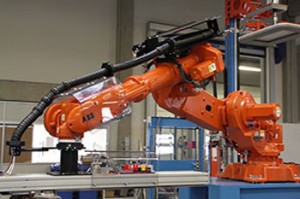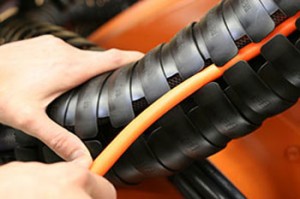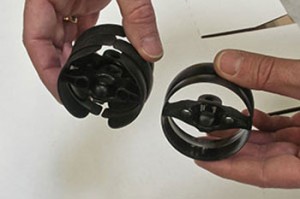Igus Triflex energy chain for palletizing robots
 An extremely small universal module Igus triflex RS is frequently used in packing systems. It mounts to preexisting fastening points on the robot and consists of a multi-axis energy supply, integrated spring rods and a cover for extra protection.
An extremely small universal module Igus triflex RS is frequently used in packing systems. It mounts to preexisting fastening points on the robot and consists of a multi-axis energy supply, integrated spring rods and a cover for extra protection.
Pictured right: The turnkey packaging plant employs a very compact Igus triflex RS universal module for its palletising robot.
This Igus triflex energy supply system easily moves in all axis and reliably guides cables even with difficult geometries. This distiguishes it from corrugated hoses, which do not hold up over the long term when exposed to pronounced rotating motions. Expensive equipment downtime is the result.
A German company relies on a universal Igus triflex module for all robot motions on its palletizing robot in a fully automated packaging line. The solution guarantees a long service life and reliability. “We have rigorously relied on robot technology for our packaging plants for about 20 years,” reports Michael Ruf, procurator and deputy general manager at Transnova-RUF Verpackungs- und Palettiertechnik GmbH in Ansbach.
“They are each tailored to the respective customer application. Each year, we integrate more than 200 robots into our plants,” he continues. “They give our customers a maximum of flexibility for the final packaging process..”
Compact universal module
A foil packaging plant that is delivered as a turnkey facility now uses a compact Igus triflex RS universal module for the palletising robot. The Igus triflex module ensures that the energy chain is always guided closely to the robot to avoid loops and unnecessary cable stresses. It is assembled on the existing mounting points on the robot and consists of an Igus triflex R multi-axis energy supply system. It combines fast insertion of the various cables with an improved connection mechanism and increased stability, therefore resulting in further improvements of machinery or plant availability.
Limit stop dogs also ensure a defined mobility limit, therefore providing additional protection. The system also uses integrated fibre rods to reliably guide the energy chain and a cover system. This is a cover that holds the energy supply system in place when the robot operates in a vertical or overhead orientation.
Efficient and reliable packaging
With some 220 employees, Transnova-RUF supplies solutions for final packaging and palletising tasks, ranging from planning to design-engineering, assembly and commissioning. The product range includes individual compact machines for top and side loading, picking systems for fast pickand place applications, and robot systems for order picking, palletising, and depalletising tasks, and even fully customised final packaging lines.
 “We are equiped to handle any type of primary packaging,” Michael Rug explains. “This ranges from button batteries for hearing aids to complete control cabinets with a length of 2.20m.”
“We are equiped to handle any type of primary packaging,” Michael Rug explains. “This ranges from button batteries for hearing aids to complete control cabinets with a length of 2.20m.”
Pictured left: Cables can be easily and conveniently clipped into the Igus triflex energy chain supply system.
Ranging from food and non-food applications to medical or pharmaceutical technology, the specialist company has flexible packaging solutions for any industry. It has seen double digit growth for years. 75 percent of its customers are located in Germany, and 90 percent of these are repeat customers. They are expanding existing plants or rely on the specialist for new investments.
“Our robot palletising technology is principally characterised by high flexibility and a maximum of reliability,” the procurator clarifies. Modular function groups allow handling of cartons, buckets, bags, plastic buffers, etc. The picking tools are capable of handling a wide range of pallets and intermediate layers.
In total, a foil packaging plant has a length of 60m. Each foil roll is dedicated to a customer-specific order. Each foil roll can have a different length and/or thickness, and a resulting difference in weight. The foil material itself also differs. The various foil rolls are fed to the packaging plant in a chaotic manner and need to be flexibly handled based on the sequenced production orders. “This task is predestined for robot technology,” explains Michael Ruf. “A total of nine robots are in use.”
The packaging process consists of the following steps: after production, the foils travel from cardboard rollers into the plant. Here, they are staged in a buffer or sorting station before they are subsequently coated with a protective hose-foil. The hose-bag protrusion is blown into the roll core with compressed air. The primary packaging unit has now been packaged and is then individually packaged, labelled, and sealed. The product is then palletised on two pallets by a long-arm robot. A top stretch winding secures the two respective pallet packaging units.
“The packaging plant will be operated 24/7,” says Michael Ruf. “The respective packaging weight ranges between 2kg and 60kg. The conveyor technology speed is approx. 40 m/min. 20 rolls per minute can be packaged.”
Four-fold load capability
The requirements profile for the energy supply system is quickly summarised: long service life and high mechanical protection for cables. Axis 3 to 6 in particular are subject to pronounced rotating motions. A corrugated hose cannot rotate around its own axis. When torsion occurs, there is a risk that it will tear and disintegrate into its constitutent components. The entire plant shuts down. Cable damage must also be prevented for the long-term. For the named reasons, the packaging specialist has decided to rely on a plastic energy supply system.
 Pictured right: The additional stop dog on the Igus triflex ensures even greater stability. The bending radius increases four-fold.
Pictured right: The additional stop dog on the Igus triflex ensures even greater stability. The bending radius increases four-fold.
The multi-dimensionally moving multi-talent Igus triflex R is permanently torsionable. The high flexibility is an additional feature. A rotation of approx. ±10° per chainlink in the length axis is possible. This makes guiding cables around difficult geometries child’s play. In contrast to corrugated hose, Igus triflex also has a defined radius, which prevents kinking or damaging cables. The dual chamber system in the Igus triflex is yet another feature that ensures a clean interior separation. Bus and compressed air lines can be routed separately through the Igus triflex.
But this application has even more advantages: even greater tensile force absorption is accomplished with the updated trailer mechanism in the B version of the Igus triflex. It provides greater stability due to an additional stop dog. Due to its modular design, the energy chain can in principle be easily shortened or lengthened. In contrast to other commercially available systems, where the individual elements are connected with wire ropes, this allows length changes to be made quickly and conveniently. The Igus triflex R system connection works based on the trailer mechanism, similar to a trailer hitch. Due to the new operating principle of the Igus triflex R version, the bending radius load capability is increased by four-fold. In addition, much larger torsion forces are compensated.
The retract system with the two integrated fibre rods is an additional feature. The Igus triflex energy chain is located closely to the robot arm and always returns to its original position without hooking or forming loops. The cover, which protects the entire Igus triflex system, can also accommodate valve terminals when required, allowing the generally restricted installation space on robot applications to be exploited further.
Visit the Igus website for more information on Igus triflex.
See all stories for Igus















